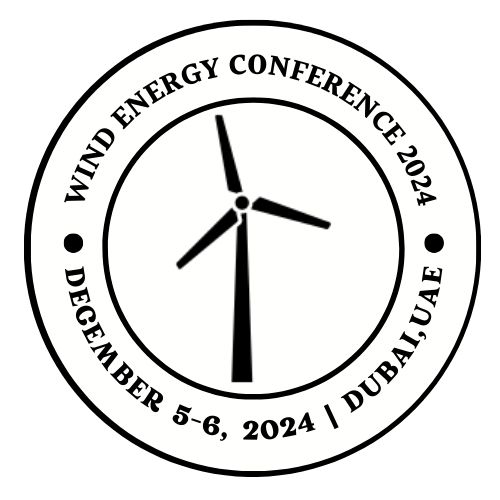Conference Information
Welcome Message
Dear Esteemed Participants,
It is with great pleasure that we welcome you to the "Wind Energy Conference 2024," scheduled to take place from December 05-06, 2024, in the beautiful city of Dubai, UAE.
This global event offers a remarkable opportunity for professionals, scholars, and practitioners in the field of wind energy to gather and share their knowledge, perspectives, and experiences. We are privileged to host an extraordinary group of experts, and we look forward to learning and growing together during this conference.
Under the theme "Beyond the Blades: The Future of Wind Technology and its Applications," the conference will provide a platform to discuss and explore various cutting-edge technologies and methodologies that are shaping the future of wind energy. We aim to delve into the significant advancements and innovative applications that are driving the industry forward.
Your involvement and valued contributions to this event are highly appreciated. We eagerly anticipate engaging in stimulating discussions, insightful presentations, and beneficial networking opportunities throughout the conference.
Once again, welcome to the Wind Energy Conference 2024. We hope you find your time here to be both productive and fulfilling.
About the Wind Energy Conference 2024
About the Wind Energy Conference 2024:
This Wind Energy Conference 2024 will delve into the exciting world of wind energy, exploring the latest advancements, industry trends, and future directions. It provides a platform for key stakeholders to connect, share knowledge, and collaborate in accelerating the adoption of wind power for a sustainable future.
What's New in Wind Energy:
Cutting-edge turbine technology: Discover advancements in blade design, drivetrains, materials, and automation for improved efficiency, cost reduction, and wider applications.
Grid integration and storage solutions: Explore innovative strategies for seamlessly integrating wind power with the electricity grid, including energy storage technologies.
Offshore wind power: Gain insights into the latest developments in offshore wind farms, addressing challenges and opportunities in this rapidly growing sector.
Financing and investment trends: Learn about the evolving financial landscape of wind energy, including new investment models and risk mitigation strategies.
Sustainability and environmental considerations: Explore wind energy's role in combating climate change, while addressing ecological concerns associated with turbine development.
Who Should Attend?
This Wind Energy Conference 2024 is a valuable resource for a wide range of wind energy professionals, including:
- Wind turbine manufacturers and developers
- Utility companies and grid operators
- Investors and financiers
- Policymakers and regulators
- Researchers and academics
- Consultants and service providers
- Environmental advocates and community stakeholders
Target Audiences:
Technical Professionals: Engineers, scientists, and researchers interested in the latest technological advancements in wind turbine design, operation, and maintenance.
Project Developers and Investors: Individuals involved in developing, financing, and investing in wind energy projects.
Policymakers and Regulators: Government officials and regulators shaping the future of wind energy policy and regulations.
Utilities and Grid Operators: Professionals working on integrating wind power into the electricity grid and managing its variability.
Environmental NGOs and Community Representatives: Individuals concerned with the environmental impact of wind energy and promoting community engagement.
By bringing together these diverse groups, the Wind Energy Conference 2024 fosters collaboration and accelerates the development and deployment of wind energy solutions for a cleaner and more sustainable future.
Market Analysis
Wind Energy Market Segmental Analysis
The global wind energy market is categorized by type, application, and region. In terms of type, it is divided into offshore and onshore segments. Offshore wind energy involves turbines located in bodies of water, offering advantages like stronger winds and less visual impact on land. This segment is growing due to technology advancements and supportive regulations.
Onshore wind energy, located on land, has been the dominant contributor to the market, benefiting from lower installation costs and existing infrastructure.
End-Use Analysis
Wind energy serves various end-users:
Industrial: Provides sustainable power to manufacturing plants and industrial complexes, reducing carbon emissions and energy costs.
Commercial: Meets high energy demands of office buildings, retail stores, and hotels, aiding in sustainability goals and cost reduction.
Residential: Increasingly adopted by households and communities for local electricity generation through small turbines or community projects.
Regional Insights on the Wind Energy Market
In 2022, Asia-Pacific led the global wind energy market in revenue share, driven by government initiatives to enhance energy infrastructure. The region is expected to continue growing steadily. North America, particularly the U.S., shows promise with increasing electricity demand and advanced wind energy technology, offering significant commercial opportunities.
Wind Energy Market Dynamics
Environmental Concerns: Growing awareness of climate change drives demand for wind energy, reducing greenhouse gas emissions from traditional power sources.
Government Support: Favorable policies like feed-in tariffs and tax incentives worldwide encourage investment in wind energy, fostering market growth.
Land and Grid Challenges: Limited suitable land for onshore wind farms in densely populated areas and intermittent nature of wind energy pose grid integration challenges.
Capital Costs: High initial investment required for wind projects, including turbine installation, is a financial barrier for smaller players and developing regions.
Key Market Trends in Wind Energy
Expansion of Offshore Wind: There is a notable shift towards offshore wind projects due to their ability to accommodate larger capacities, utilize favorable wind conditions, and minimize visual impact compared to onshore installations. This trend is particularly prominent in coastal regions.
Technological Innovations: Advances in wind turbine technology, including higher capacities, improved efficiency, and enhanced control systems, are driving market trends. These innovations aim to increase energy output, reduce maintenance costs, and enhance the competitiveness of wind energy against other power sources.


